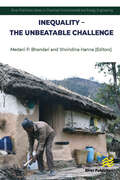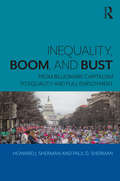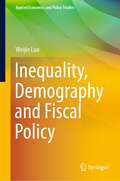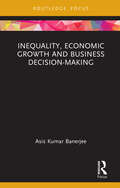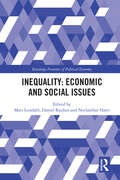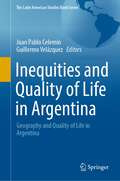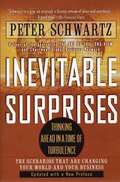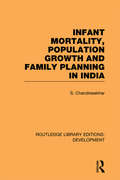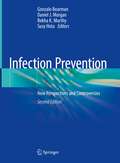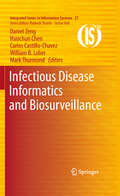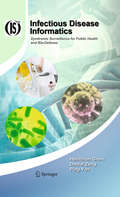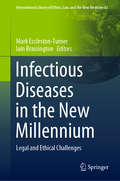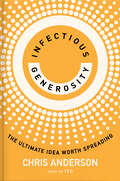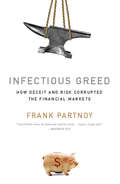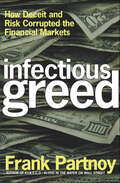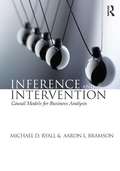- Table View
- List View
Inequality – the unbeatable challenge
by Medani P. Bhandari Shvindina HannaThis edited book presents some unexplored issues of economic inequality, including case studies of various countries. Inequality is a chronic and divisive factor of society. Inequality exists as an integral attribute of human development. Communities, nations, and systems are not evolving at the same speed and rate and thus require different resources in different amounts. However, the distribution of winnings is also uneven due to the multidimensionality of influencing factors.When we talk about inequality, it is not just inequality of income or wealth; it is first, inequality in access to priorities and human needs – to shelter, to clean water, air, health care, and also to appropriate vaccination systems and assistance, security systems and safety guarantees for the future. Past financial crises and the current pandemic shock has revealed bugs in the system, shaking it and changing our perception of the norms.We may have no doubts that inequality is an unsolved problem, but now we need to find out - is it unbeatable? There is still lack of knowledge around how inequality has been grounded throughout human civilization, why society is stratified and classified, economically, politically, socially, and religiously; and why the discrimination due to gender, sexual orientation, country of origin, language differences, immigration status, caste, race and ethnicity? This book addresses these issues in a holistic way as well as including case studies of various countries. It tries to find out why inequality has been unbeatable and what would be the best policies to overcome this challenge.
Inequality, Boom, and Bust: From Billionaire Capitalism to Equality and Full Employment
by Howard J. Sherman Paul D. ShermanThere is enormous inequality between the income and wealth of the richest 1 percent and all other Americans. While the top 1 percent own 42 percent of all wealth in America, the lower half on the income ladder has only 2 percent of all of the wealth. This book develops a viewpoint contrary to the prevailing conservative paradigm, setting out both reasons for this inequality and the impact of this. To explain inequality, conservative economists focus on individual characteristics such as intelligence and hard work. This book puts forward new evidence to show that changes in economic inequality are primarily due to characteristics inherent in the standard operation of capitalist institutions. Furthermore, the authors seek to explain the cycle of boom and bust by considering political and social factors often overlooked by conservative economists. This book also explores how wealth influences political policies in a way that increases economic inequality even more than its present level. Through analysis of American political and economic institutions, Inequality, Boom, and Bust presents concrete steps for an activist, progressive policy to greatly reduce inequality through free healthcare, free higher education, and reduced unemployment.
Inequality, Demography and Fiscal Policy (Applied Economics and Policy Studies)
by Weijie LuoThis book aims to empirically and theoretically study how income inequality and demographic change affected fiscal policy and subsequent economic growth globally in the past decades from four perspectives. First, it briefly reviews the dynamic changes of income sources that contribute to inequality. Second, it distinguishes between income inequality induced by differences in labor productivity and income inequality induced by differences in capital income. Third, it briefly reviews the dynamic changes of tax composition in the age of demographic change. Last, it discusses the impacts of changes in age structure on the extent of taxes on income relative to expenditure. This book offers a comprehensive discussion to understand and analyze the reason, performance and challenge of fiscal policy and economic growth from the perspective of inequality and demographics.In addition to students, teachers and researchers in the areas of equity, demography, political economy and economic policy, this book is also of great interest to policy makers, planners and non-government agencies who are concerned with understanding and addressing poverty-related and aging-related issues in developed and developing countries.
Inequality, Economic Growth and Business Decision-Making (Routledge Focus on Management and Society)
by Asis Kumar BanerjeeIt is now widely recognised that rising inequality of income and wealth on the one hand and a slowdown in the rate of economic growth on the other are two of the most important challenges faced today by the global economy as well as by most of the developing economies. This book starts by explaining how these two issues are interrelated. There is no dearth of books on the role that the economic policies of the government can play in meeting these twin challenges. The role of business managers in the private sector of the economy, however, is a relatively neglected area. This book seeks to close this gap in the literature. The central message of the book is that, contrary to popular belief, it is in the interests of private business itself that business managers take into account the effects that their decisions have on the economy as a whole. It is shown that a failure to do so would hurt their own economic prospects in both the short run and the long. Emphasis is given on the importance of an appropriate orientation of managerial decisions and on the role of investors (i.e. the suppliers of capital) in inducing managers to take socially optimal decisions. The book is addressed as much to business managers and students in management courses as to the general reader. Therefore, no prior knowledge of advanced economic theory is presumed. All arguments are built from first principles.
Inequality, Geography and Global Value Chains (The Academy of International Business)
by Jong Min Lee J. Eduardo Ibarra-Olivo Katiuscia Lavoratori Liang Arthur LiThis contributed volume provides theoretical and empirical insights into a variety of contemporary issues about inequality, geography, and global value chains in today’s world, where global disruptions are prevalent, globalization is being transformed, and multinational enterprises (MNEs) are under pressure to promote sustainability. Many challenges and tensions created by growing inequality within and between countries, cities, and individuals, coupled with recent disruptions in the global economy, beg important questions regarding the role of MNEs. A valuable resource for scholars and students in international business, the book provides a richer understanding of how MNE activities are being affected by the complex dynamics of the modern global business environment and discusses what strategies they need to implement in order to adapt to a changing world, while accounting for the interests of a broader range of stakeholders.
Inequality, Inclusive Growth, and Fiscal Policy in Asia (Routledge-GRIPS Development Forum Studies)
by Donghyun Park Sang-Hyop Lee Minsoo LeeDeveloping Asia’s sustained rapid growth has improved general living standards and lifted hundreds of millions of Asians out of poverty within a generation. Yet the region now finds itself confronting rising inequality. Countries where inequality has worsened over the past 2 decades collectively account for over 80% of Asia’s population. As a result, governments across the region have begun to accord a higher priority to promoting more inclusive growth. The international experience, especially the experience of the advanced economies, suggests that fiscal policy can make a potent contribution to reducing inequality. This book systematically explores the relationship between both sides of fiscal policy—public spending as well as taxes and other fiscal revenues—and inequality in Asia at great depths. On the basis of the analysis, the book sets forth a number of concrete options for rendering fiscal policy a more effective tool for more inclusive growth that benefits all Asians. Inequality, Inclusive Growth, and Fiscal Policy in Asia is written in response to an issue of growing demand in most Asian countries, and it comes at a time when Asian governments are also beginning to use fiscal policy to bridge the glaring disparities between the rich and the poor of the region. As such, the book will be a highly valuable reference for researchers, policy makers, and students as well.
Inequality, Output-Inflation Trade-Off and Economic Policy Uncertainty: Evidence From South Africa
by Eliphas Ndou Thabo MokoenaThis book focuses on income inequality, output-inflation trade-off and economic policy uncertainty in South Africa. Tight monetary and macroprudential policies raise income inequality. Income inequality transmits monetary policy and macroprudential policy shocks to real economic activity. Economic policy uncertainty influences the dynamics in the lending rate margins, inflation expectations, credit, pass-through of the repo rate to bank lending rates and companies’ cash holdings. The trade-off between output and inflation and output growth persistence vary with inflation regimes. Stimulatory demand policy shocks are less effective in high inflation regime. High income inequality raises consumption inequality, which raises demand for credit, but price stability matters in this link. Increased bank concentration raises income inequality, lowers economic growth and employment rate. Elevated economic policy uncertainty lowers output growth, lowers capital formation, reduces credit and raises companies’ cash holdings. Increased companies’ cash holdings reduce capital formation and impact the transmission of expansionary monetary policy shocks to real economic activity. This book shows there is an inflation level within the target band below it which lowers income inequality, while raising GDP growth and employment. Thus price stability, economic policy uncertainty and income inequality matter for the efficient transmission of policy shocks.
Inequality, Polarization and Conflict
by Satya R. ChakravartyThis monograph initially offers a systematic treatment of the theory and methodology of alternative notions of income polarization and related issues. It then goes on to analyze social polarization, ordinal polarization, and the relations between inequality polarization, fractionalization and likelihood of conflicts. Axiomatic approaches to the measurement of polarization from different perspectives are analyzed rigorously. In order to understand the difference between inequality and polarization, a discussion on income inequality is also included.
Inequality: An Entangled Political Economy Perspective (Palgrave Studies in Classical Liberalism)
by Mikayla Novak‘This book is a thoroughly researched and well written exploration of one of the most divisive topics in modern democratic discourse. Novak brings careful and clear thinking to a topic too often clouded in emotion and guided by moral intuition. ‘—Peter Boettke, Professor of Economics and Philosophy, George Mason University, USA‘Inequality has bred a climate of hostile political discourse reminiscent of the cold war. In this lucid book, Novak explains how we can transcend that hostility by recognizing the deeply entangled character of politics and economics within modern societies.’—Richard E. Wagner, Hobart R. Harris Professor of Economics, George Mason University, USA‘Mikayla Novak has provided a bold new intellectual foundation for social policy analysis.’ —Jason Potts, Professor of Economics, RMIT University, AustraliaIn recent years the degree of income and wealth inequality within developed countries has been raised as a central issue in economic and social policy debates. Numerous figures across diverse ideological affinities have advocated policy measures to significantly alter income and wealth distributions, while the inequality debate has become infused with other subjects such as social justice and identity politics. This book presents an account of economic inequality from a contemporary classical liberal perspective. Inequality is seen as a by-product of entangled relationships within society, bringing to the fore key ideas from complexity, evolutionary and network sciences.Novak illustrates that inequality is problematic insofar as it generates pro-rich redistribution and constrains progress by the less well off. Economic inequality has important links with issues such as fiscal and regulatory policies, discrimination and social exclusion, and institutional design.This unique book is important reading for social science academics, policy makers and people interested in exploring the dimensions and solutions to inequality, a critical issue of our time.
Inequality: Economic and Social Issues (Routledge Frontiers of Political Economy)
by Mats Lundahl Neelambar Hatti Daniel RauhutInequalities of opportunity affect a person’s life expectancy and access to basic services and human rights through discrimination, abuse, and lack of access to justice. High levels of inequality of opportunity discourage skill accumulation, choke economic and social mobility, and, consequently, depress economic growth. Inequality also entrenches uncertainty, vulnerability, and insecurity; undermines trust in institutions and government, increases social discord and tensions, and triggers violence and conflicts. This book presents wide-ranging perspectives on economic inequality, as measured by differences in incomes and wealth. The contributors to the book explore how the economy is shaped in such a way as to generate differences in economic and social welfare between individuals, regions, and nations. But the book is not limited to economic perspectives: inequality is a many-faceted phenomenon that manifests itself in a number of ways.Thus, the book begins with a section which highlights some of the ‘standard’ features of inequality: class, gender, and age. The second section explores the manifestation of inequality in terms of differences in income and wealth. The third section looks at some of the causes of inequality, exploring the effects of discrimination and plunder (by those in power). The final section serves to drive home the point that geographic and institutional factors have an important place as well when it comes to shedding light on what equality is, how it manifests itself, and what its consequences are.This book will be essential reading for anyone interested in the causes and consequences of economic inequality including those in economics, sociology, politics, and geography.
Inequities and Quality of Life in Argentina: Geography and Quality of Life in Argentina (The Latin American Studies Book Series)
by Juan Pablo Celemin Guillermo VelázquezThe basis of this proposal is the study of quality of life from an interdisciplinary perspective. This volume presents a set of contributions from different sciences that analyse the quality of life in Argentina. The contributions come from the social disciplines (Geography, Economics, Demography, History) and from the field of health (Nutrition, Medicine, Psychology) as well as the applied sciences (Statistics, Applied Mathematics). The purpose is to present various dimensions related to the well-being of the population, particularly in relation to poverty, human development, health, nutrition and morbidity. Although there are works from different sciences associated with the object of study, they all have a geographic component based on cartography. Consequently, the importance of geography is highlighted, as the territorial base allows for the study quality of life from a unique perspective where the map emerges as a fundamental descriptive tool. Such an approach is useful to diagnose the quality of life and its uneven spatial distribution, either through index or different associated variables. Thus, the maps are fundamental to study the territorial configuration of the quality of life at the different scales of analysis, showing spatial inequalities and the areas where it is necessary to take measures to improve the population's living conditions.
Inevitable Surprises: Thinking Ahead in a Time of Turbulence
by Peter Schwartz"One of America's foremost prognosticators and author of the bestseller and management classic The Art of the Long View discusses the big surprises ahead, the resulting scenarios that are creating the future of our world, and what they will mean for you and your business. The world we live in today is more volatile than ever. At times it seems that the only constant we can rely on is change itself-and what the future will bring appears to be anybody's guess. But Peter Schwartz, one of the most visionary scenario planners of our time, believes the future is taking shape around us now, and that by taking a closer look at the changes in action today, we can predict what the world of tomorrow will be like. With Inevitable Surprises, Schwartz offers a provocative look at the forces that are dramatically reshaping our world-and shows what we can do to plan ahead for our society, our businesses, and ourselves. Each chapter takes a predetermined new reality that we will soon face-including regenerative medicine, global climate change, an aging population in the West, and the rise of terrorism-and offers critical foresight for the coming decad
Infamous Players
by Peter BartIn 1967, Peter Bart, then a young family man and rising reporter for the New York Times, decided to upend his life and enter into the dizzying world of motion pictures. Infamous Players is the story of Bart's whirlwind journey at Paramount, his role in its triumph and failures, and how a new kind of filmmaking emerged during that time. When Bart was lured to Paramount by his friend and fellow newcomer, the legendary Robert Evans, the studio languished, its slate riddled with movies that were out of touch with the dynamic sixties. By the time Bart had left Paramount in 1975, the studio had completed a remarkable run with such films as The Godfather, Rosemary's Baby, Harold and Maude, Love Story, Chinatown, Paper Moon, and True Grit. But this new golden era at Paramount was also fraught with chaos and company turmoil. Drugs, sex, runaway budgets, management infighting, and even the Mafia started finding their way onto the Paramount backlot, making it surely one of the worst-run studios in the history of the movie industry. As Peter reflects on the New Hollywood era at Paramount with behind-the-scenes details and insightful analysis, here too are his fascinating recollections of the icons from that era: Warren Beatty, Steve McQueen, Robert Redford, Clint Eastwood, Jack Nicholson, Marlon Brando, Al Pacino, Francis Ford Coppola, Roman Polanski, and Frank Sinatra among others. For over five decades, first on the inside as a studio executive, and later as the longtime editor-in-chief of Variety, Peter Bart has viewed Hollywood from an incomparable vantage point. The stories he tells and the lessons we learn from Infamous Players are essential for anyone who loves movies.
Infant Mortality, Population Growth and Family Planning in India: An Essay on Population Problems and International Tensions (Routledge Library Editions: Development)
by S. ChandrasekharFirst published in 1972, this reissue deals with the crucial issue of population explosion, one of the most crucial problems facing the contemporary developing world. Written by a world-renowned demographer and family planning specialist, the book deals specifically with the Indian experience. Reviewing population change in India over the last century, Professor Chandrasekhar focuses on three key issues: the socioeconomic repercussions of reduced infant mortality in twentieth-century India; the rapid population growth from 1871 and its implications on India’s efforts to raise her standard of living; and finally India’s valiant efforts to promote family planning amongst her hundred million married couples.
Infection Control at Massachusetts General Hospital
by Robert S. Huckman Nikolaos TrichakisThe case explores the challenges facing Massachusetts General Hospital concerning the adoption of a new infection control policy, which promises to improve operational performance, patient safety, and profitability. The new policy requires coordination between different departments within the hospital, namely the Emergency Department, the Infection Control Unit, and Admission Services. Students are initially asked to assess the operational, financial and clinical implications of the new policy. They are then asked to examine different approaches to its implementation.Objective: The case allows readers to examine a setting where internal coordination across different departments provides significant aggregate benefits for an organization. Coordination in this case, however, also leads to inequitable allocation of costs and benefits across the different departments, which then provides students with an opportunity to explore various implementation challenges and strategies.
Infection Control at Massachusetts General Hospital (Abridged)
by Robert S. Huckman Nikolaos TrichakisThe case explores the challenges facing Massachusetts General Hospital concerning the adoption of a new infection control policy, which promises to improve operational performance, patient safety, and profitability. The new policy requires coordination between different departments within the hospital, namely the Emergency Department, the Infection Control Unit, and Admission Services. Students are initially asked to assess the operational, financial and clinical implications of the new policy. They are then asked to examine different approaches to its implementation. Objective: The case allows readers to examine a setting where internal coordination across different departments provides significant aggregate benefits for an organization. Coordination in this case, however, also leads to inequitable allocation of costs and benefits across the different departments, which then provides students with an opportunity to explore various implementation challenges and strategies.
Infection Prevention: New Perspectives and Controversies
by Gonzalo Bearman Daniel J. Morgan Rekha K. Murthy Susy HotaThe first edition of Infection Prevention reviewed evolving areas in infection prevention on topics including contact precautions, technology implementation, specific infections, and care in various settings. It summarized the current data on infection prevention, presents controversies on the various topics, and includes recommendations for patient safety. Addressing hot topics such as MRSA, C. difficile vaccination, mandatory flu vaccines, and CLABSI, this is the only text to include prevention and control overviews across a range of infection issues. Written by experts in the field, this successor edition will update current chapters on the most cutting-edge models of care on emerging and evolving topics in infectious diseases. It will also include new material and chapters on high-level disinfection, diagnostic test stewardship, unique pathogens units, outpatient antibiotic stewardship, outpatient antibiotic therapy, as well as a chapter on infection prevention metrics: how much can we prevent healthcare associated infections and how hard should we try. The second edition of Infection Prevention: New Perspectives and Controversies is a valuable resource for infection prevention professionals, healthcare quality and safety professionals, caring for patients in in- and outpatient settings.
Infectious Disease Informatics and Biosurveillance
by Daniel Zeng Hsinchun Chen Mark Thurmond Carlos Castillo-Chavez William B. LoberThis book on Infectious Disease Informatics (IDI) and biosurveillance is intended to provide an integrated view of the current state of the art, identify technical and policy challenges and opportunities, and promote cross-disciplinary research that takes advantage of novel methodology and what we have learned from innovative applications. This book also fills a systemic gap in the literature by emphasizing informatics driven perspectives (e.g., information system design, data standards, computational aspects of biosurveillance algorithms, and system evaluation). Finally, this book attempts to reach policy makers and practitioners through the clear and effective communication of recent research findings in the context of case studies in IDI and biosurveillance, providing "hands-on" in-depth opportunities to practitioners to increase their understanding of value, applicability, and limitations of technical solutions. This book collects the state of the art research and modern perspectives of distinguished individuals and research groups on cutting-edge IDI technical and policy research and its application in biosurveillance. The contributed chapters are grouped into three units. Unit I provides an overview of recent biosurveillance research while highlighting the relevant legal and policy structures in the context of IDI and biosurveillance ongoing activities. It also identifies IDI data sources while addressing information collection, sharing, and dissemination issues as well as ethical considerations. Unit II contains survey chapters on the types of surveillance methods used to analyze IDI data in the context of public health and bioterrorism. Specific computational techniques covered include: text mining, time series analysis, multiple data streams methods, ensembles of surveillance methods, spatial analysis and visualization, social network analysis, and agent-based simulation. Unit III examines IT and decision support for public health event response and bio-defense. Practical lessons learned in developing public health and biosurveillance systems, technology adoption, and syndromic surveillance for large events are discussed. The goal of this book is to provide an understandable interdisciplinary IDI and biosurveillance reference either used as a standalone textbook or reference for students, researchers, and practitioners in public health, veterinary medicine, biostatistics, information systems, computer science, and public administration and policy.
Infectious Disease Informatics: Syndromic Surveillance for Public Health and Bio-Defense (Integrated Series in Information Systems #21)
by Daniel Zeng Hsinchun Chen Ping YanComputer-based infectious disease surveillance systems are capable of real-time or near real-time detection of serious illnesses and potential bioterrorism agent exposures and represent a major step forward in disease surveillance. Infectious Disease Informatics: Syndromic Surveillance for Public Health and Bio-Defense is an in-depth monograph that analyzes and evaluates the outbreak modeling and detection capabilities of existing surveillance systems under a unified framework, and presents the first book-length coverage of the subject from an informatics-driven perspective. Individual chapters consider the state of the art, including the facilitation of data collection, sharing and transmission; a focus on various outbreak detection methods; data visualization and information dissemination issues; and system assessment and other policy issues. Eight chapters then report on several real-world case studies, summarizing and comparing eight syndromic surveillance systems, including those that have been adopted by many public health agencies (e.g., RODS and BioSense). The book concludes with a discussion of critical issues and challenges, with a look to future directions. This book is an excellent source of current information for researchers in public health and IT. Government public health officials and private-sector practitioners in both public health and IT will find the most up-to-date information available, and students from a variety of disciplines, including public health, biostatistics, information systems, computer science, and public administration and policy will get a comprehensive look at the concepts, techniques, and practices of syndromic surveillance.
Infectious Diseases in the New Millennium: Legal and Ethical Challenges (International Library of Ethics, Law, and the New Medicine #82)
by Iain Brassington Mark Eccleston-TurnerThis book examines the often tough questions raised by infectious diseases through essays that explore a host of legal and ethical issues. The authors also offer potential solutions in order to ensure that past errors are not repeated in response to future outbreaks. The essays touch on a number of key themes, including institutional competence, the accountability and responsibility of non-state actors, the importance of pharmaceuticals, and the move towards a rights-based approach in global health.Readers gain insights into such important questions as follows: How can we help victims in other countries? What (if any) responsibility should be placed upon international organizations whose actions exacerbate infectious diseases? How can we ensure that pharmaceutical research helps all communities, even those who cannot afford to pay for the products? While broadly covering global health law, the book adopts an inter-disciplinary approach that draws on public international law, philosophy, international relations, human rights law, and healthcare economics. As such, it is a valuable resource for academic libraries, appealing to scholars and postgraduates engaged in relevant research, as well as to those engaged with global health and policy at the international level.
Infectious Generosity: The Ultimate Idea Worth Spreading
by Chris AndersonThe bestselling author, media pioneer, and curator of TED explores one of humankind&’s defining but overlooked impulses, and how we can super-charge its potential to build a hopeful future—&“an essential read to kick off the new year&” (Forbes, &“16 Must Have Books and Podcasts for Leaders in 2024&”)&“I flew through these pages with an increasing sense of joy. I hope that millions read this book.&”—Elizabeth Gilbert, author of Eat, Pray, LoveLet&’s face it: Recent years have been tough on optimists. Hopes that the Internet might bring people together have been crushed by the ills of social media. Is there a way back?As head of TED, Chris Anderson has had a ringside view of the world&’s boldest thinkers sharing their most uplifting ideas. Inspired by them, he believes that it&’s within our grasp to turn outrage back into optimism. It all comes down to reimagining one of the most fundamental human virtues: generosity. What if generosity could become infectious generosity? Consider • how a London barber began offering haircuts to people experiencing homelessness—and catalyzed a movement• how two anonymous donors gave $10,000 each to two hundred strangers and discovered that most recipients wanted to &“pay it forward&” with their own generous acts• how TED itself transformed from a niche annual summit into a global beacon of ideas by giving away talks online, allowing millions access to free learningIn telling these inspiring stories, Anderson has given us &“the first page-turner ever written about human generosity&” (Elizabeth Dunn). More important, he offers a playbook for how to embark on our own generous acts—whether gifts of money, time, talent, connection, or kindness—and to prime them, thanks to the Internet, to have self-replicating, even world-changing, impact.
Infectious Greed: How Deceit and Risk Corrupted the Financial Markets
by Frank PartnoyAs the global financial crisis unfolds people everywhere are seeking to understand how markets devolved to this perilous, volatile state. In this dazzling and meticulously researched work of financial history, first published in 2003, and now thoroughly revised and updated, law professor and financial expert Frank Partnoy tells the story of how "classical" Wall Street securities like stocks and bonds were quietly eclipsed by ever more "quantum" products like derivatives. He documents how, starting in the mid-1980s, each new level of financial risk and complexity obscured the sickness of corporate America, and how Wall Street's evlving paradigm moved farther and farther beyond the understanding-and regulation-of ordinary investors and government overseers, leading inevitably to disaster.
Infectious Greed: How Deceit and Risk Corrupted the Financial Markets
by Frank PartnoyFrom the bestselling author of F.I.A.S.C.O., a riveting chronicle of the rise of dangerous financial instruments and the growing crisis in American businessOne by one, major corporations such as Enron, Global Crossing, and Worldcom imploded all around us, prey to a greed-driven culture and dubious or illegal corporate finance and accounting.In a compelling and disturbing narrative, Frank Partnoy's Infectious Greed brings to bear all of his skills and experience as a securities attorney, financial analyst, law professor, and bestselling author to tell the story of the rise of the trading instruments and corporate financial structures that imperil the economic health of the country. Starting in the mid-1980s with the introduction of the first proto-derivatives, and taking us through such high-profile disasters as Barings Bank and Long Term Capital Management, Partnoy traces a seamless progression to today's dangerous manipulations. He documents how each new level of financial risk and complexity obscured the sickness of the company in question, and required ever more ingenious deceptions. It's an alarming story, but Partnoy offers a clear vision of how we can step back from the precipice.
Infectious: How to Connect Deeply and Unleash the Energetic Leader Within
by Achim NowakTechnology has transformed the way we communicate. We send and receive more and more emails every day. We text. We tweet. We have reduced our communications down to efficient sound bites—and at the same time, many of us seem to know less and less about how to connect. Deeply, profoundly connect. In Infectious, acclaimed performance coach Achim Nowak introduces the reader to his powerful four Levels of Connection. Tested and honed through fifteen years of coaching senior-level executives around the globe, Nowak’s techniques instantly transform the skills taught in traditional business communication and NLP programs. People who connect deeply with others connect on four levels: They shape conversations with effortless grace, and they play consciously with the unspoken elements of a connection—personal power, intention, and energy. The result? Infectious connections that accelerate personal success! Infectious offers simple language cues that deepen and shift the art of conversation. It breaks the idea of power into five tangible plugs that we can turn to—and turn on. These plugs recharge the quality of our connection with anyone we meet. It shows how we can clarify our intentions, and how this clarification immediately fosters a more potent connection. Finally, this book demystifies the experience of energy—the deepest of the four levels, and the root of any connection. It looks at how we access our energy. Remove energy blocks. Play with energy and own it. This highly practical book reshapes the hidden forces of a connection into simple, step-by-step actions. Apply the tools of Infectious and generate your own infectious connections!
Inference and Intervention: Causal Models for Business Analysis
by Michael D. Ryall Aaron L. BramsonRyall and Bramson's Inference and Intervention is the first textbook on causal modeling with Bayesian networks for business applications. In a world of resource scarcity, a decision about which business elements to control or change – as the authors put it, a managerial intervention – must precede any decision on how to control or change them, and understanding causality is crucial to making effective interventions. The authors cover the full spectrum of causal modeling techniques useful for the managerial role, whether for intervention, situational assessment, strategic decision-making, or forecasting. From the basic concepts and nomenclature of causal modeling to decision tree analysis, qualitative methods, and quantitative modeling tools, this book offers a toolbox for MBA students and business professionals to make successful decisions in a managerial setting.
